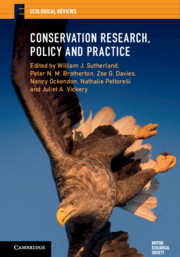15 results
Part I - Identifying priorities and collating the evidence
-
- Book:
- Conservation Research, Policy and Practice
- Published online:
- 18 April 2020
- Print publication:
- 16 April 2020, pp 27-142
-
- Chapter
-
- You have access
- Open access
- HTML
- Export citation
Chapter One - Making a difference in conservation: linking science and policy
- from Introduction and scene setting
-
-
- Book:
- Conservation Research, Policy and Practice
- Published online:
- 18 April 2020
- Print publication:
- 16 April 2020, pp 3-8
-
- Chapter
-
- You have access
- Open access
- HTML
- Export citation
Chapter Twenty - Successfully translating conservation research into practice and policy: concluding thoughts
- from Conclusion
-
-
- Book:
- Conservation Research, Policy and Practice
- Published online:
- 18 April 2020
- Print publication:
- 16 April 2020, pp 325-328
-
- Chapter
-
- You have access
- Open access
- HTML
- Export citation
Part II - Influencing and making decisions
-
- Book:
- Conservation Research, Policy and Practice
- Published online:
- 18 April 2020
- Print publication:
- 16 April 2020, pp 143-262
-
- Chapter
-
- You have access
- Open access
- HTML
- Export citation
Contents
-
- Book:
- Conservation Research, Policy and Practice
- Published online:
- 18 April 2020
- Print publication:
- 16 April 2020, pp vii-ix
-
- Chapter
-
- You have access
- Open access
- HTML
- Export citation
Contributors
-
- Book:
- Conservation Research, Policy and Practice
- Published online:
- 18 April 2020
- Print publication:
- 16 April 2020, pp x-xvi
-
- Chapter
-
- You have access
- Open access
- HTML
- Export citation
Part III - Communicating the message
-
- Book:
- Conservation Research, Policy and Practice
- Published online:
- 18 April 2020
- Print publication:
- 16 April 2020, pp 263-322
-
- Chapter
-
- You have access
- Open access
- HTML
- Export citation
Introduction and scene setting
-
- Book:
- Conservation Research, Policy and Practice
- Published online:
- 18 April 2020
- Print publication:
- 16 April 2020, pp 1-26
-
- Chapter
-
- You have access
- Open access
- HTML
- Export citation
Plate Section (PDF Only)
-
- Book:
- Conservation Research, Policy and Practice
- Published online:
- 18 April 2020
- Print publication:
- 16 April 2020, pp 337-356
-
- Chapter
-
- You have access
- Open access
- HTML
- Export citation

Conservation Research, Policy and Practice
-
- Published online:
- 18 April 2020
- Print publication:
- 16 April 2020
-
- Book
-
- You have access
- Open access
- Export citation
Copyright page
-
- Book:
- Conservation Research, Policy and Practice
- Published online:
- 18 April 2020
- Print publication:
- 16 April 2020, pp vi-vi
-
- Chapter
-
- You have access
- Open access
- HTML
- Export citation
Conclusion
-
- Book:
- Conservation Research, Policy and Practice
- Published online:
- 18 April 2020
- Print publication:
- 16 April 2020, pp 323-328
-
- Chapter
-
- You have access
- Open access
- HTML
- Export citation
Index
-
- Book:
- Conservation Research, Policy and Practice
- Published online:
- 18 April 2020
- Print publication:
- 16 April 2020, pp 329-336
-
- Chapter
-
- You have access
- Open access
- HTML
- Export citation
What Works in Conservation 2018
-
- Article
-
- You have access
- HTML
- Export citation
Restoring nature with evidence
-
- Article
-
- You have access
- HTML
- Export citation



